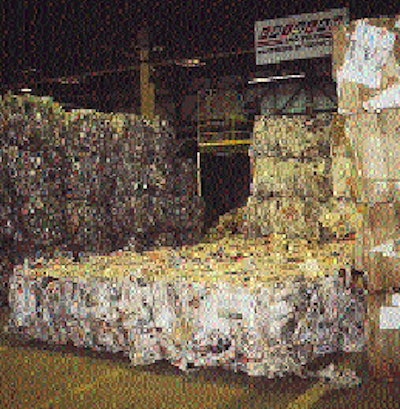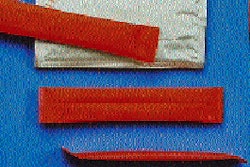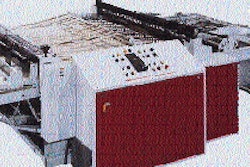To cope with its burgeoning volume of recyclables, Laidlaw Waste Systems' Schaumburg, IL, material recovery facility (MRF) last December installed an automated sortation/separation system from Bulk Handling Systems (Eugene, OR). At the heart of this system is a plastic singulation process from Magnetic Separation Systems (Nashville, TN), that separates polyvinyl chloride (PVC), polyethylene terephthalate (PET), clear or natural high-density polyethylene (HDPE), colored HDPE and mixed plastics. According to MSS, Laidlaw is the first MRF to use the system. Approximately 30 similar systems are operating within the U.S., but at third-party plastic processing facilities that buy baled materials from MRFs. BHS acts somewhat as the general contractor on the sortation system, subcontracting the plastics separation system to MSS. Added this Spring, this separation capability permits Laidlaw to accept plastics beyond the PET soft drink and HDPE milk jug containers to which it was once limited. Since switching to the BHS/MSS systems, Laidlaw "is saving $47ꯠ a month in labor," according to Gary Buccilli, Laidlaw's Northern Illinois market material recovery facilities manager. "We've gone from using 39 people on three shifts to 12 on two, and that's despite a leap in our daily throughput," he says. "Depending on pricing factors in the markets where we sell our separated materials, we expect to earn a 24-month payback on the systems." Volumes of plastic, aluminum, glass, steel and tin continue to grow as the Northern Illinois communities served by Laidlaw become more accustomed to collecting these containers, bagging them and placing them at curbside. These materials now account for 80% of the MRF's incoming volume, with plastics representing 18% to 22% of this figure. And while not heavy by weight, they do require considerable space and efficient sortation. "When the plant first opened, we had a nice separation system for these commingled containers," says Buccilli. "But we just outgrew it. We had to add people to help separate containers because of our increasing material volumes." That led to a rather labor-intensive process. Commingling Within the Northern Illinois area, Laidlaw trucks also pick up trash, hauling it to Chicagoland area landfills. Yard waste is collected and delivered to the company's Rockford, IL, compost facility. Recyclables, however, are brought to the Schaumburg MRF. Partitioned trucks stop at separate "bunkers" or "pits" within the MRF to drop off newspapers, mixed fiber and corrugated. Operators sort newspaper from magazines and coated paper materials as they index along a conveyor in one corner of the facility. Plastics, aluminum, glass and steel proceed through a much more sophisticated process. The 'tipping pit' The truck empties its load of commingled materials into a "tipping pit." An operator uses a skid-steer loader to scoop up the items and dump them into an infeed hopper. Materials convey along a 25' inclined conveyor, then past a cross-belt magnetic head that lifts steel and tin, depositing those materials onto a perpendicular conveyor where they're released down a chute to a densifier that compacts the containers into bricks. Non-steel or tin materials pass the magnetic head pulley through a trommel, or circular barrel, that's perforated to separate small pieces of broken glass. Operators manually separate amber, green and clear glass onto conveyors that whisk the materials through an outer wall via chutes into separate dumpsters just outside the MRF. Whole glass, plastic and aluminum that pass this trommel convey through a wind chamber, or air knife, that blows plastic and aluminum to an "A-sort" line, while gravity pulls the heavier glass down a "B-sort" line. At the beginning of the A-sort line, a disc screen separates any residual broken glass shards, which are delivered to an outside dumpster. Small plastic and aluminum containers pass through an eddy current that propels the aluminum through the air to a machine that flattens it and blows it to a "trailer." The small plastic materials are pulled downward by gravity to another conveyor that empties into a moveable cart. Meanwhile, large, bottle-grade plastic containers convey to the Magnetic Separations Systems' BottleSort® singulation system. The system automatically orients bottles single-file, Buccilli explains, "to prevent any piggybacking or doubling up of containers." Sorting plastics The MSS portion of the system uses a central processing unit and two optical scanning sensors (X-ray and Primary Identification Removal) to identify plastic containers. Containers pass through this sensor area and within five milliseconds, the CPU takes some 5ꯠ readings. The CPU and the two sensors communicate this information to help identify resin type. An X-ray tube emits a low-level light charge. Since PVC absorbs X-rays more readily than other plastics, it is detected, and the computerized sensor system tracks the bottle along the conveyor until it reaches the PVC ejection point. At this time, an air blast blows the bottle down a hooded chute and into a separate moveable bin. Non-PVC containers are identified by the PIR sensor, which uses information from the CPU to determine container orientation, shape and location. The PIR sensor uses an array of measurements to make a primary resin identification. MSS considers the specifics of the process proprietary, but does say the determinations are based, at least in part, on opacity. In order, Laidlaw uses the system to identify PET, then natural HDPE, mixed color HDPE, and finally mixed/other plastics, and nonclassified items. The CPU sends signals to air jets that eject these different materials, in this same order, into separate moveable bins. These moveable bins are wheeled to another area within the facility where they are compacted into bales by a Harris (Peachtree City, GA) Model HRB8 baler and strapped. Steel-banded bales are brought to a staging area, then placed into trucks for delivery to users of the recovered materials. The MRF recovers and sells 96% of the materials it collects, according to Buccilli. Separated materials are compacted into a bale that's placed on a pallet and banded with steel strapping. Plastics are sold to regrinders and pelletizers, carpet manufacturers and plastic lumber producers. Paper mills, boxboard factories and insulation manufacturers purchase recovered fiber materials, including corrugated, newspaper, office paper, and juice boxes. Glass makers buy glass; aluminum processors welcome back aluminum cans for sheet manufacture; smelters take steel and tin containers. When Laidlaw Waste Systems opened the Schaumburg MRF four years ago, it used 18 trucks. These trucks collected up to 120 tons of recyclables a day from approximately 75ꯠ homes and 25 businesses within eight northern Illinois communities. Then, the MRF accepted newspaper, aluminum cans, corrugated, kraft bags and magazines, as well as limited quantities of glass, plastic and steel containers. Today, 24 trucks collect 200 tons of recyclables on an average day, from 150ꯠ homes and 150 businesses within 15 communities. And the company now picks up PET, HDPE and PVC containers, as well as plastics categorized as "others". The company also acquires clear, green and amber glass; varying grades of corrugated; newspapers and office paper; multilayer juice containers; plastic beverage carrier rings; aluminum cans; steel and tin containers; and white goods. "The MRF is our own kingdom. It's critical for us to be able to sort these recyclables and upgrade them," says Buccilli." The more, the merrier Buccilli says that in the scrap industry, upgrading refers to separating materials into specific categories. For example, recovered fiber can be sold at a higher price if it's suitable for printing, compared with fiber appropriate only for inner liner board. "The more we can break items down and separate them, the cleaner the scrap will be and the more consistent the grade of material for the buyer of that particular material. With the automated systems we now have in place, we're effective at that." Laidlaw this Spring initiated a program aimed at boosting collection of pizza boxes. Adding another material to the list of "saleable" recyclables benefits Laidlaw. Essentially, Buccilli ascribes to "the more, the merrier," in that by collecting a diverse range of recyclable materials, Laidlaw limits the amount of material destined for landfillilling. He says communities find this desirable. More recyclables also open additional sales opportunities. "But," he realizes, "there's quite a balancing act involved in managing labor costs and ever-changing recyclables pricing. What we bale and sell today may well change tomorrow. We have to keep a close eye on prices for these materials. The decisions that ultimately make or break our facility are made almost on a minute-by-minute basis."
























